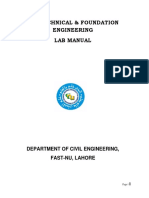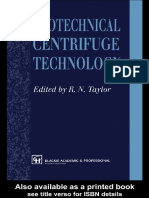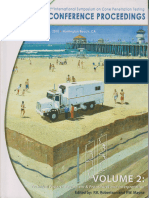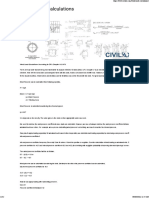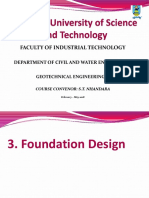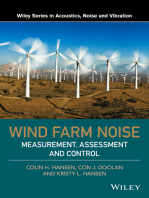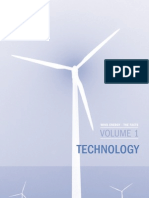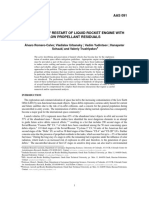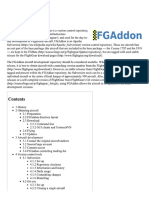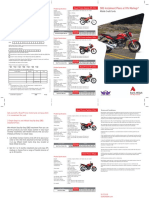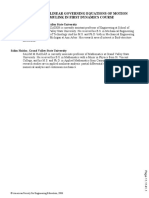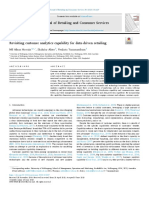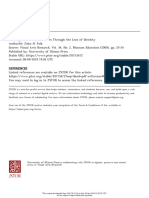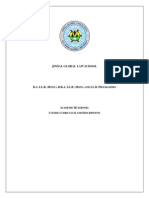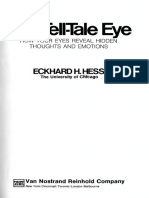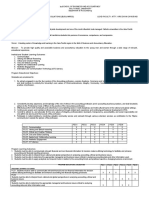The Evolution of Wind Turbine Design Analysis-A Twenty Year Progress Review
The Evolution of Wind Turbine Design Analysis-A Twenty Year Progress Review
Uploaded by
endoparasiteCopyright:
Available Formats
The Evolution of Wind Turbine Design Analysis-A Twenty Year Progress Review
The Evolution of Wind Turbine Design Analysis-A Twenty Year Progress Review
Uploaded by
endoparasiteCopyright
Available Formats
Share this document
Did you find this document useful?
Is this content inappropriate?
Copyright:
Available Formats
The Evolution of Wind Turbine Design Analysis-A Twenty Year Progress Review
The Evolution of Wind Turbine Design Analysis-A Twenty Year Progress Review
Uploaded by
endoparasiteCopyright:
Available Formats
WIND ENERGY
Wind Energ., 1, 524 (1998)
Review
Article
The Evolution of Wind Turbine
Design AnalysisA Twenty Year
Progress Review
D. C. Quarton,* Garrad Hassan and Partners Ltd, The Coach House, Folleigh Lane,
Long Ashton, Bristol BS18 9JB, UK
Key words:
wind turbine
design;
evolution;
future
developments
The sophistication of the analytical methods used as the basis of wind turbine design has
increased enormously over the last 20 years. Beginning with simple calculations based
largely on engineering intuition, the approach to wind turbine design has been transformed to the point where sophisticated computer-based analysis is now performed
routinely throughout the industry. This article traces the evolution of wind turbine design
analysis, examines the factors which have inuenced this evolution and assesses the
current state of the art. The article concludes with a discussion of the remaining areas of
uncertainty and the likely future developments of wind turbine calculation methods.
c 1998 John Wiley & Sons, Ltd.
*
Introduction
The behaviour of a modern wind turbine is made up of a complex interaction of components and
subsystems and its design requires the skills of a multidisciplinary team of engineers with expertise in
diverse areas: atmospheric wind ow, rotor aerodynamics, control, mechanical systems, electrical systems
and civil engineering. The design problem is particularly complicated since wind turbines have little
respect for engineering conventions. There are many examples of the rather unique nature of wind
turbines: the blade aerofoils which may be required to operate in stall, the power train components which
are subject to highly irregular inputs and the number of fatigue cycles experienced by the major structural
components which can be orders of magnitude greater than for other rotating machines. The importance
of fatigue in the design of a wind turbine is evident when the design life of a modern commercial machine,
amounting to perhaps 15 years of unattended operation, is compared with that of a typical motor vehicle
which may be equivalent to about four months of manned operation.
Wind turbine technology has a unique technical identity and unique demands in terms of the methods
used for design. This article, building on an earlier review by Quarton et al.,1 attempts to describe the way
in which wind turbine design analysis has evolved and reviews the current state of the art.
Historical Perspective
Over the last 20 years a number of factors have facilitated, or in some cases driven, the development of
ever more sophisticated wind turbine design analysis. Some of the more important are considered below.
Research
In addition to the internally funded, commercially driven research undertaken within the industry, the
funding and execution of national and international research programmes have played a vital role in
*Correspondence to: D. C. Quarton, Garrad Hassan and Partners Ltd, The Coach House, Folleigh Lane, Long Ashton, Bristol BS18 9JB, UK.
Email: quarton@garradhassan.co.uk
# 1998 John Wiley & Sons, Ltd.
D. C. Quarton
facilitating a gradual improvement in the understanding of the technology of wind turbine engineering.
Through the use of knowledge gained from fundamental research, demonstration projects and measurement programmes, research workers have been able to develop and validate mathematical models which
provide ever more reliable representations of both wind turbine behaviour and wind input. Validation of
the mathematical models has been and clearly remains a crucial aspect of the wind turbine research
programme and has depended on the availability of high quality measurements. A particularly important
European Union (EU) funded research project in this context was the `Wind turbine benchmark exercise
on mechanical loads', completed in 1991.2 This project, which involved the collaboration of organizations
from several European countries, enabled the rst co-ordinated investigation of the maturity and
reliability of contemporary wind turbine computer models.
The Trend Towards Low-cost, Large-scale Wind Turbines
The pursuit of lower costs for wind-generated electricity has driven manufacturers to less conservative,
more optimized machine design at an increasingly large scale. Table I illustrates the growth in the size of
commercial wind turbines since 1980.
Table I. Increasing size of commerical wind turbines since 1980
Year
Capacity (kW)
Rotor diameter (m)
19801983
19841985
19861988
19891992
19931994
19951996
1997
55
75
120
250
400500
500750
6001500
15
17
21
27
3740
4048
4366
In order to reduce design conservatism and hence achieve lower unit costs without increasing the risk of
machine failure, the manufacturers have required design calculation methods which are more reliable and
less conservative than the simplistic approaches used in the early days of the industry. Figure 1, based on
data taken from Reference 3, shows how the price per kW has reduced with increasing capacity to the
point where it is presently rather insensitive to scale for the latest, medium to large designs.
The Increasing Power of Computers
Computer processing power and available memory have increased at a phenomenal rate over the 20 years
that the modern wind turbine industry has existed. Using standard desktop PC hardware, it is now
possible for a designer to make use of calculation methods and design software that would have been
Figure 1. Price per kW of commercial wind turbines
# 1998 John Wiley & Sons, Ltd.
Wind Energ., 1, 524 (1998)
Twenty Year Review of Wind Turbine Design Analysis
impossible using the computer hardware generally available in the early 1980s. The increased power and
memory of computers, coupled with the possibilities for extremely user-friendly software environments,
allow the wind turbine designer to undertake sophisticated design calculations in a straightforward and
convenient manner.
Certication Rules and Design Standards
The certication of wind turbines has become an increasingly important requirement for the industry, not
only in Europe but now further aeld in the previously unregulated market of the US and the emerging
markets in South America, Asia and Australasia. In markets where there may be no legal requirement,
certication is often a commercial necessity in order for a wind project to attract both investment and
insurance cover.
In northern Europe, particularly in Denmark, Germany and the Netherlands, certication of wind
turbines has long been required in order for wind projects to obtain building permits and/or to become
eligible for subsidies. In these three countries, rules and standards have been developed as the basis of
certication and have had a direct inuence on the methods used by manufacturers for their design
calculations and procedures. In the early days of the industry the certication rules were based on
simplied methods for calculating the loads used for design purposes. The `design loads' for a wind
turbine comprise a full denition of the fatigue and extreme loads predicted for the lifetime of the
machine, taking account of all operating, non-operating and fault condition situations. In recent times, as
the understanding of wind turbine behaviour has improved and the size of machines has considerably
increased, the certication agencies are demanding the use of more sophisticated methods for the
calculation of these design loads.
The recently developed international wind turbine safety standard IEC 1400-14 species a minimum list
of physical phenomena which should be considered in design calculations. Representation of the
phenomena specied in the standard requires a sophisticated treatment of wind turbine loading including,
for example, realistic modelling of wind turbulence and unsteady aerodynamics. A problem yet to be
resolved in the context of certication rules and design standards is that although safety factors are
required to be used to account for uncertainty in the design calculations, there is no provision for such
factors to be changed depending on the sophistication and reliability of the calculation method.
Modelling of Wind Turbines
A wind turbine is composed of a number of subsystems: the rotor, power train, control and safety system,
nacelle structure, tower and foundations. A model suitable as the basis of design calculations of loading
will provide representations of these components and subsystems as well as an appropriate treatment of
the incident wind eld.
The external loading of a wind turbine is derived mainly from the aerodynamic wind forces acting on
the rotor. Although early design calculations for wind turbines were often based on a highly simplied,
quasi-steady treatment of the rotor aerodynamic loading, coupled with some rudimentary means of
estimating the appropriate dynamic magnication of loads for each machine component, such methods
have now largely been discounted.
A clear example of this move away from such simplied calculation methods is provided by the recent
amendment by Germanischer Lloyd of their Regulations for the Certication of Wind Energy Conversion
Systems.5 The amendment, issued in July 1995, states that the use of simplied calculations of fatigue load
spectra is now acceptable only in the case of the single category of three-bladed rotors of less than 46 m
diameter. The previously accepted simplied method involved the generation of component fatigue load
spectra from the mean loads at the rated wind speed of the wind turbine. This approach, although
undoubtedly conservative for certain components of a wind turbine, is now recognized as unsafe for
# 1998 John Wiley & Sons, Ltd.
Wind Energ., 1, 524 (1998)
D. C. Quarton
Figure 2. Comparison of yaw fatigue load spectra for a 65 m rotor
others, particularly in the case of large machines. Figure 2 shows the tower top yaw moment fatigue load
spectrum calculated for a 65 m diameter, three-bladed wind turbine operating on a site with an annual
mean wind speed of 10 m s71 and an ambient turbulence of 20%. Two calculations are presented, one
derived from rigorous simulation of the wind turbine with a realistic model of the turbulent wind eld,
and the second, based on the recently abandoned simplied method, which uses the mean rotor thrust at
the rated wind speed to calculate the yaw loads assuming that the thrust vector is acting at a radial
eccentricity. The magnitude of the yaw fatigue loading acting on a wind turbine is now recognized to be
crucially dependent on the structure of the turbulence through which the rotor sweeps, and the dangers of
adopting simplistic approaches for design load calculations which neglect the inuence of turbulence are
evident from the substantial discrepancy between the two results shown in Figure 2.
Current wind turbine design calculations of fatigue and extreme loads are almost invariably based on
a rigorous treatment of the aeroelastic nature of the problem, with proper account taken of aerodynamic, gravity, inertial, centrifugal and gyroscopic loads and the distributed stiness properties of the
structure.
A Frequency or Time Domain Problem?
In common with random loading problems in many other elds of engineering, the analysis of wind
turbine fatigue loads may, in principle, be carried out using either frequency or time domain techniques.
The frequency domain approach to the calculation of structural response to random loading has rm
foundations in both wind engineering and the analysis of wave loading of oshore structures. The method
becomes complicated for a wind turbine because of the need to deal with the rotation of the rotor blades
slicing through the turbulent structure of the incident wind eld. This problem was rst considered by
Rosenbrock6 in the 1950s and the method was subsequently developed by Madsen et al.7 and Garrad and
Hassan.8 The turbulent wind eld is represented by an expression for the temporal and spatial cross
correlation of wind speed uctuations which is transformed to a frame of reference moving with the rotor
blades. In order to compute the dynamic response and loading of the wind turbine, this cross correlation
function is integrated with some linear model of the rotor aerodynamics and a structural dynamics model,
typically based on a modal representation. The response and loading output of the calculation is obtained
nally in spectral form through inverse Fourier transforms of the correlation functions. Computation of
# 1998 John Wiley & Sons, Ltd.
Wind Energ., 1, 524 (1998)
Twenty Year Review of Wind Turbine Design Analysis
fatigue damage from the spectral output of loads can be undertaken either by an appropriate synthesis of
loading time series for subsequent rainow cycle counting or by use of so called `direct spectral methods'
capable of generating rainow cycle distributions directly from load auto-spectra.9
Although the frequency domain approach has the advantage that it provides for a very rapid analysis of
wind turbine loading, it suers from the disadvantage that it cannot take account of system non-linearities
associated, for example, with the rotor aerodynamics, structural dynamics and/or control system
dynamics. For this reason in particular, the frequency domain approach is not currently used as the basis
of nal, detailed wind turbine design calculations. The method is, nevertheless, of some value in the very
early stages of wind turbine design for optimization studies. In addition, Quarton10 has recently described
the use of the frequency domain method for the computation of the combined wind and wave loading of
oshore wind turbines.
The time domain approach to calculating the response of a system subject to some disturbance is
termed simulation. Simulation is a widely used method and the techniques involved are well understood.
Simulation forms the basis of all current, state-of-the-art wind turbine design calculations. The main
features of the method are described below.
Wind Field Representation
Until relatively recently, calculations of the loading and behaviour of wind turbines were based on grossly
simplied models of the wind. It was common to assume a representation based on a steady wind speed, a
constant power or logarithmic law model of wind shear, a constant yaw misalignment and a constant ow
inclination. Although such input taken together with some representation of the tower shadow eect
enables a satisfactory calculation of the periodic loading, it provides no basis for evaluating the random
loads due to turbulence.
The importance of turbulent loading is now universally recognized. A model of the wind eld suitable
for design loading calculations requires good representation of both the temporal and spatial structure of
the turbulence. Early models concentrated on representation of the longitudinal component of turbulence, although it is now common practice to base load calculations on a model of the three turbulent
velocity components.
A number of methods have been developed for the simulation of turbulent wind, and good reviews are
presented by Powell and Connell11 and more recently by Winkelaar.12 All these methods use, as a starting
point, auto-spectral and coherence descriptions of the turbulence. More comprehensive models are that
due to Mann13 based on a representation of the spectral tensor of atmospheric surface layer turbulence,
and that reported by Bierbooms and Dragt.14
Although current design standards and certication rules accept the use of standard spectral models of
turbulence such as von Karman15 and Kaimal,16 see for example IEC 1400-1,4 a considerable body of
research has been undertaken in order to investigate their adequacy for a range of atmospheric stability
conditions and for representation of the turbulence associated with ow over complex terrain and within
wind farms.1720 The problem is complicated and further work will undoubtedly be required before it will
be possible to formulate reliable guidelines to assist the wind turbine designer.
Turbulence models of the form described above are now widely used for the calculation of fatigue
loads for design purposes. For calculation of extreme loads, however, it is standard practice to base
calculations on deterministic descriptions of extreme wind conditions. Current design standards and
certication rules specify extreme events in terms of discrete gusts, wind direction changes and wind
shear transients, see for example Figure 3 which shows the form of the extreme operating gust proposed
for the imminent revision of IEC 1400-1. The form, amplitude and time period specied for these
discrete events remain rather arbitrary and largely unvalidated. The development of more reliable
methods for the evaluation of extreme design loads, based possibly on the use of probabilistic analysis,
requires considerable eort but is crucially important in the context of rening wind turbine design
analysis.21,22
# 1998 John Wiley & Sons, Ltd.
Wind Energ., 1, 524 (1998)
10
D. C. Quarton
Figure 3. Form of extreme operating gust proposed for revision of IEC 1400-1. Example based on 1 year return period,
V(z) 25 m s71 and s1 3.9 m s71
Rotor Aerodynamics
A thorough review of the present state of the art with regard to rotor aerodynamics is given by Snel.23
The treatment of rotor aerodynamics which forms the basis of all current design methods for the
calculation of wind turbine loads is combined blade element and momentum theory.24 In the early days of
the industry, wind turbine aerodynamicists borrowed this approach from the world of propeller design
where it was conceived in the 1930s. Although the method initially found favour not so much because of
its rigour but more for its convenience, it has proved to be remarkably reliable. Two major extensions of
this theory which have, however, been researched in recent years are the development of dynamic wake25
and stall hysteresis26 models. These models, which attempt to deal with the unsteady nature of wind
turbine rotor aerodynamics, are now considered as the state of the art and are generally incorporated in
design calculations.
The use of combined blade element and momentum theory for time domain simulations of wind
turbine behaviour has traditionally been based on the so called `equilibrium wake' model where the rotor
wake and hence the induced velocity ow eld react instantaneously to changes in blade loading. An
alternative is to assume the `frozen wake' model where the induced velocity eld is computed according to
the mean, uniform ow conditions and then xed or frozen in time. In reality neither of these treatments is
strictly correct. Changes in blade loading change the vorticity that is trailed into the rotor wake, and the
full eect of these changes takes a nite time to aect the induced velocity eld. A `dynamic wake' model,
of which there are several forms,25 is able to provide a representation of this dynamic process.
In the case of stall hysteresis there are again a number of dierent models available, although there is
certainly a dearth of reliable validation. The various models, originating again from the eld of helicopter
aerodynamics, attempt in dierent ways to represent the complex stall process on a wind turbine blade
operating in unsteady ow where the incidence of the ow is changing rapidly. In this situation the onset
of stall may be delayed considerably in excess of the static stall angle. When dynamic stall does occur,
however, it is usually more severe than static stall, and the attendant forces and moment acting on the
aerofoil may exhibit large hysteresis with respect to the instantaneous angle of attack. This represents an
important contrast to the quasi-steady case, for which the ow eld adjusts immediately and uniquely to
each change in incidence.
Although the rst application of stall hysteresis models to wind turbines was in the context of vertical
axis machines, their use for horizontal axis congurations was motivated in the mid-1980s by a concern
that large stall regulated machines might suer from severe stall-induced vibrations. This concern was
generated largely as a result of early measurements of the behaviour of the Nibe A wind turbine in
Denmark. Analysis of these measurements27 suggested that the machine suered considerable vibrations
and dynamic loading in stall. The vibrations were thought to be due to the loss of aeroelastic damping of
the motion of the blades, but much uncertainty surrounded the inuence of unsteady aerodynamic eects.
# 1998 John Wiley & Sons, Ltd.
Wind Energ., 1, 524 (1998)
Twenty Year Review of Wind Turbine Design Analysis
11
Figure 4. Comparison of measured and predicted apwise bending moment at blade root of Nordex 250 kW operating
at 17 m s71
Prior to the incorporation of stall hysteresis models, calculations of wind turbine behaviour were based
on the quasi-steady blade element approach theory described above. This approach generally results in an
underprediction of aeroelastic damping associated with stalled ow and hence an overprediction of the
level of structural vibrations when compared with measurements. Research reported by Rasmussen et al.26
has shown that by taking account of unsteady aerodynamic eects through the use of a stall hysteresis
model, the predicted dynamic behaviour is better damped and generally a better match with reality.
Figure 4 shows the eect of stall hysteresis on the quality of the prediction of the apwise bending moment
acting at the blade root of the Nordex 250 kW wind turbine. This machine has a three bladed, stall
regulated rotor of 26 m diameter.
Figure 4(a) shows the time history of the root bending moment measured in a wind speed of 17 m s71
where the blade is operating in stall. Figure 4(b) presents the prediction of the bending moment for the
same wind conditions and based on a quasi-static model of the rotor aerodynamics. It is clear from these
results that the quasi-static aerodynamic model is completely inadequate, resulting in periods of unstable
blade bending vibrations which are not to be found in the measured data. The predicted results in
Figure 4(c) have been obtained through the use of a stall hysteresis model26 which has introduced
# 1998 John Wiley & Sons, Ltd.
Wind Energ., 1, 524 (1998)
12
D. C. Quarton
positive aeroelastic damping to the blade dynamics, providing much closer agreement with the measured
data.
Stall delay on the inboard sections of rotor blades, due to three dimensional and rotational ow eects,
has been widely conrmed by studies at both model and full scale; see for example Reference 28. A
number of semi-empirical methods29,30 have been developed for correcting two-dimensional aerofoil data
to account for stall delay, and such methods are widely used for the design analysis of stall regulated
rotors. The major problem with such semi-empirical models is the uncertainty regarding their reliability
across a range of aerofoils, blade planforms and rotor sizes.
Owing to the complexity of the problem and despite the extensive research eort conducted in this area
to date, the representation and to some extent the general understanding of aerodynamic stall on a
rotating wind turbine blade remain poor, a rather extraordinary situation in view of the importance of
stall regulation to the industry. The current uncertainty associated with stall aerodynamics has the eect
of limiting the level of condence that can be placed in design calculations of both steady and dynamic
rotor performance and loading. A recent and well-publicized example of an unexpected design problem
associated with stall is that of the occurrence of leadlag stall-induced vibrations on certain commercially
available blades.31 There is clearly much yet to be learnt, and it is generally recognized that the modelling
of stall is the most signicant inadequacy of current design calculation methods.
Research funding has been and continues to be used for the development of more sophisticated
treatments of rotor aerodynamics. Such work includes the development of vortex methods and Navier
Stokes codes. The rst complete ow solution for a rotating wind turbine blade has been derived by
Hansen et al.32 using a NavierStokes code. This work, which continues under the VISCWIND33 project
funded by the EU, represents a signicant step forward, providing an improved understanding of aerodynamic stall and oering within the foreseeable future a means of tuning semi-empirical models of the
phenomenon. Considerable work is also under way to improve the understanding and the reliability
of modelling of the aerodynamic noise developed by wind turbine rotor blades; see for example
Reference 34.
Structural Dynamics
In the early days of the industry, design loads were evaluated on the basis of quasi-static aerodynamic
calculations, with the eects of structural dynamics either ignored completely or included through the use
of estimated dynamic magnication factors. From the late 1970s, research workers began to consider
more reliable methods of dynamic analysis, and two basic approaches were considered: nite element
representations and modal analysis. A review of the development of wind turbine dynamic modelling
techniques is given by Garrad35 and the state of the art is presented in the proceedings of a recent `Meeting
of Experts' organized under the auspices of the International Energy Agency (IEA) and focusing on the
subject of aeroelastic codes for wind turbine calculations.36
The traditional use of standard, commercial nite element analysis codes for dealing with problems of
structural dynamics is problematic in the case of wind turbines. This is because of the gross movement of
one component of the structure, the rotor, with respect to another, the tower. Standard nite element
packages are only used to consider structures in which motion occurs about a mean undisplaced position.
For this reason the nite element models of wind turbines which have been developed have been specially
constructed to deal with the problem; see for example References 3739.
Although it is entirely possible to derive the dynamic behaviour of a wind turbine by means of a direct,
time marching, numerical solution of the dierential equations of motion which represent the bending of
the rotor blades as beam structures,40 the form of wind turbine dynamic modelling most commonly used
as the basis of design calculations is that involving a modal representation. This approach, borrowed from
the helicopter industry, has the disadvantage that the model construction requires considerable algebraic
manipulation in order to derive the system equations of motion, but the major advantage that it oers a
reliable representation of the dynamics of a wind turbine with relatively few degrees of freedom. The
# 1998 John Wiley & Sons, Ltd.
Wind Energ., 1, 524 (1998)
Twenty Year Review of Wind Turbine Design Analysis
13
algebraic manipulation involved in the derivation of the modal equations of motion is, in fact, well suited
for treatment using the Lagrangian approach by means of computer algebra. A review of this approach is
given by Garrad and Quarton.41
The modal equations of motion for the wind turbine will involve mass, damping and stiness matrices
which are full owing to the coupling of the degrees of freedom and contain periodic coecients because of
the time dependent interaction of the dynamics of the rotor and tower. In the early days of the industry
there was considerable concern regarding the potential for aeroelastic instability of wind turbines as a
result of the coupling of the dierent dynamic degrees of freedom. Attention was therefore focused on
developing methods capable of derivation of the system stability characteristics.42,43 The periodicity of the
coecients of the equations of motion means that it is not possible to check the system stability and
determine the resonant frequencies of the rotating system using standard eigenvalue analysis. For a rotor
with three or more blades it is possible to eliminate the periodicity by means of suitable transformation of
the co-ordinates of the modal degrees of freedom.44 However, for a one- or two-bladed rotor the most
widely used method was that known as FloquetLiapunov theory, which is cumbersome and timeconsuming in its application.
The results of early investigations of aeroelastic stability were rather dull but at the same time reassuring
in that instabilities were only found well outside the operational envelope of the wind turbines considered.
In hindsight it seems clear that the early emphasis given to stability studies came largely as a result of the
concerns of helicopter dynamicists rightly preoccupied with issues of aeroelastic stability in their own
eld. In recent years and with the benet of considerable operating experience, concerns regarding
aeroelastic instability of mainstream wind turbine designs have been somewhat allayed and formal
stability analysis is now rarely undertaken within the design process. It seems clear, however, that with the
advent of increasingly exible structural components at an ever larger scale, the potential for aeroelastic
instability of future wind turbine designs should not be dismissed lightly. As a measure aimed at reducing
the risk associated with the development of a new, large-scale wind turbine prototype, the execution of a
thorough aeroelastic stability analysis would seem entirely sensible.
It should be stressed that although the well-publicized phenomenon of stall-induced vibrations of
certain rotor blades31 can be rightly regarded as an aeroelastic instability, it is somewhat dierent from
those instabilities referred to in the foregoing discussion since it is widely accepted to be associated with
the loss of aeroelastic damping of one or more vibrational modes due entirely to operation of the rotor in
stall. The aeroelastic stability analysis discussed above is concerned with instabilities which may occur
with the rotor operating in attached ow and generally involving the coupling of two or more vibrational
modes of the wind turbine system.
The number and type of modal degrees of freedom used to represent the dynamics of a particular wind
turbine will clearly depend on the conguration and structural properties of the machine. State-of-the-art
methods36 generally oer representation of blade bending modes in both apwise and edgewise directions,
rotor teeter, drive train torsion, tower bending in two directions, nacelle yaw and/or tower torsion.
Through comparisons with measurements, such modal models have demonstrated that in general they can
oer the accuracy required for use in design.
It is relatively uncommon for blade torsional exibility to be modelled for design calculations since
current commercial rotor blades remain rather sti in torsion. The representation of torsional dynamics
will become more important as blade structures become more exible, bringing the potential for
considerable elastic coupling of the blade torsional and apwise bending motions.
At present, largely because of the very extensive computer processing requirements associated with the
use of nite element models and similar representations such as oered by the multibody dynamics code
ADAMS,45 the state of the art in the context of wind turbine dynamic modelling for design analysis is
based squarely on the use of limited degree of freedom modal models. There are two factors which may
change this situation: the trend towards very exible wind turbine components exhibiting large deections
which cannot be modelled reliably by linear modal theory, and the increasing power of computer
hardware enabling the use of the nite element approach for design analysis.
# 1998 John Wiley & Sons, Ltd.
Wind Energ., 1, 524 (1998)
14
D. C. Quarton
In an attempt to determine the extent to which the modal representation of wind turbine dynamics
remains valid in the context of a exible machine design, research reported by Quarton46 has recently been
undertaken involving detailed measurements and computer modelling of the Carter 300 wind turbine.
The design concept of the Carter 300 is markedly dierent from that of other wind turbines on the market,
incorporating signicant structural exibility in its major components. The machine has a two-bladed,
teetered and downwind rotor of 24.2 m diameter and incorporates passive yaw tracking. The hub height is
50 m and the tower is supported by four guy cables.
It has been concluded from this work that in general the modal representation of the structural
dynamics provides the basis for reliable predictions of the component loading for the operational wind
turbine. Signicant discrepancies were identied between the measured and predicted loading of the
Carter 300 operating in stalled ow conditions. Under these conditions the predicted loads were found to
exhibit larger dynamic variation than is present in the measurements owing to an underprediction of the
extent of aeroelastic damping present. This problem is associated with the uncertain modelling of
unsteady aerodynamic stall on a rotating wind turbine blade and is neither specic to the exible,
lightweight conguration of the Carter 300, nor an indication of the inadequacy of modal modelling for
such a conguration. It is, however, probable that the modal approach will not be adequate as the basis
for calculating the very large bending deections of exible rotor blades parked in very high wind speeds.
For such calculations a non-linear, nite element treatment is likely to be considerably more reliable.
Example results indicating the benet of blade exibility in reducing the bending loads acting on the
Carter 300 are shown in Figure 5. The gure shows calculations of the blade root apwise bending
moment assuming a rigid unconed blade, a rigid blade with 68 cone angle and a exible blade. The
reduction in the average blade apwise loading due to centrifugal relief associated with rstly coning and
secondly structural exibility is spectacular. The measured blade loads, 10 min average values, are
approximately an order of magnitude smaller than those predicted for the rigid blade without pre-cone.
The calculations presented in the gure were undertaken with the Garrad Hassan code BLADED47 on the
basis of a modal representation of the structural dynamics of the Carter 300.
Figures 6 and 7 present measured and calculated blade root loads corresponding to operation of the
Carter 300 over a 10 min period at a mean wind speed of 12 m s71 and a turbulence intensity of about
15%. Results are presented for both blade root apwise and edgewise bending loads in auto-spectral
form.
The root apwise bending moment is characterized by a large component acting at a frequency
corresponding to the rotational speed of the rotor, 1P (1.07 Hz). The measured load auto-spectrum
indicates more energy than is predicted at frequencies above 3 Hz, although this discrepancy is negligible
Figure 5. Carter 300 steady state blade root apwise bending loads
# 1998 John Wiley & Sons, Ltd.
Wind Energ., 1, 524 (1998)
Twenty Year Review of Wind Turbine Design Analysis
15
Figure 6. Carter 300 dynamic blade root apwise bending loads
Figure 7. Carter 300 dynamic blade root edgewise bending loads
in view of the dominance of the 1P loading. The root edgewise bending moment is characterized by the 1P
load associated with the blade weight in combination with a signicant component at the rst edgewise
resonant frequency of the blade close to 3P.
Power Train and Control System Modelling
One of the most signicant advances in the computer modelling of wind turbines for the calculation of
design loads has been in the area of power train and control system modelling. Power train and control
system designs have become increasingly sophisticated and it is widely understood that both have a major
inuence on the dynamic loading of major structural components. Current methods for design load
calculations will generally take proper account of the power train dynamics and control system behaviour.
A state-of-the-art calculation code will include reliable representations of the following.
Transmission
. Low-speed and high-speed shaft exibility.
. Flexible mounting of the gearbox or transmission bedplate.
# 1998 John Wiley & Sons, Ltd.
Wind Energ., 1, 524 (1998)
16
D. C. Quarton
. Mechanical couplings.
. Mechanical brake(s).
Electrical System
. Induction and synchronous generators.
. Variable speed power electronics.
Closed Loop Control
. Fixed speed or variable speed control algorithms.
. Active pitch/active stall control algorithms.
. Transducer and actuator dynamics.
Supervisory Control
. Machine start, stop, standby and safety system strategies.
As control systems have become more complicated, particularly with the advent of variable speed
operation, the procedures adopted for the design and commissioning of control algorithms have needed
to improve considerably. In contrast with the early days of the industry when controllers were scarcely
designed but rather `tuned' by the commissioning engineer in the eld, the design of a modern wind
turbine control system now routinely involves a great deal of computer-based analysis. Based on current
best practice, the design of the controller is initially undertaken with a linear model of the important wind
turbine system dynamics using control design methods based largely on frequency domain analysis. This
initial design is then thoroughly tested and optimized by means of time domain simulation of the
behaviour of the controlled wind turbine at all relevant wind speeds. These simulations will be undertaken
with a complete, fully non-linear model of the wind turbine including all important system dynamics and
coupled to a realistic wind turbulence model of the type already described. At this stage the controller is
likely to be incorporated as a reliable software representation of the discrete time implementation, and the
time domain simulations will be used to test the controller for robustness, optimize gain scheduling to
take account of aerodynamic non-linearities, investigate the dynamic behaviour of the power train and
test the logic required to deal with transitions between dierent control modes. Figure 8 shows the
elements of a model suitable for undertaking simulations of this kind.
As a precursor to on-site commissioning of the control system on the prototype machine, it has recently
become possible and cost-eective for a wind turbine manufacturer to undertake nal laboratory testing
of the hardware implementation of the controller through an interface with a real time simulation of the
Figure 8. Key elements of a wind turbine model for control simulation
# 1998 John Wiley & Sons, Ltd.
Wind Energ., 1, 524 (1998)
Twenty Year Review of Wind Turbine Design Analysis
17
machine. The simulation represents all the relevant aspects of the real wind turbine and, by running in real
time, the arrangement is able to provide for a thorough test and optimization of the hardware
implementation of the supervisory and closed loop controllers.
Wind Farm Design Analysis
The majority of this article is devoted to a presentation of the history and state of the art of design analysis
for wind turbines. Large-scale exploitation of wind energy takes place in wind farms and it is important to
review briey the progress that has been made in recent years in the context of wind farm design analysis.
During its lifetime of between 20 and 30 years a wind farm must produce energy sucient to repay the
money borrowed to build it with adequate coverage and returns. The understanding of the long-term wind
behaviour is thus a vital consideration. In the early days of wind farming the attitude to the proper
assessment of the wind was somewhat cavalier and that attitude resulted in some considerable diculties
for the industry. However, there are now sophisticated and reliable methods either through direct
measurement or through comparison with nearby meteorological stations which allow considerable
condence to be placed in the wind resource estimates. This matter is of vital importance for the banks
involved in the wind energy industry and hence its future.
The topography of the site can greatly aect the wind at a specic location. The wind speed will tend to
accelerate uphill and decelerate downhill. If the slopes are too steep, however, the wind may `separate'
from the terrain and produce some damaging excess turbulence and lower mean wind speed. Careful
siting is therefore essential. Some major progress has been made in the computation of local topographical eects by the Danish National Laboratory, Ris, who have published a very `user-friendly'
topographical wind ow model `WASP'48 which allows relatively inexpert users access to a very powerful
tool of computational uid dynamics. Used under the correct conditions, this tool can produce reliable
results for local ows, see for example Reference 49, and has been used extensively by the wind energy
community.
The machines within a wind farm interact one with another. This interaction occurs through the wakes
produced by the machines. When a machine operates in the wake of another, it sees not only a reduced
mean wind speed but also a much more turbulent and therefore damaging ow. It is important to keep the
machines a safe distance apart but also to keep them close enough to be cost-eective. A great deal of
eort has been devoted to understanding the behaviour of both individual wakes and whole wind
farms.1719,50
Figure 9 shows a comparison of measured and calculated mean power output of the wind turbines in
the Nrrekr Enge II wind farm in Denmark17. The lay-out of the wind farm, which consists of 42
Figure 9. Comparison of measured and calculated power output of wind turbines at Nrrekr Enge
# 1998 John Wiley & Sons, Ltd.
Wind Energ., 1, 524 (1998)
18
D. C. Quarton
Figure 10. Lay-out of wind turbines at Nrrekr Enge
Nordtank 300 kW machines, is shown in Figure 10. The agreement between the measurements and
calculations of output power deep within the wind farm represents a considerable validation of the wake
ow modelling, which is based on an axisymmetric, thin shear layer approximation of the NavierStokes
equations, described originally by Ainslie.51
As indicated above, the fatigue loading of a wind turbine in a wind farm is increased as a function of the
additional turbulence experienced through operation in the wake of upstream machines. Accurate
prediction of the intensity and spectral characteristics of the wake-induced turbulence is therefore
important in the consideration of the spacing between machines. The results in Figure 11 show the
variation of turbulence intensity measured at a meteorological mast on the wind farm of seven Vestas
225 kW machines on Andros. The site topography is extremely complex, but the very high turbulence
intensities at wind directions of about 508 and 2408 are due to the inuence of triple and quadruple wind
turbine wakes. The calculated results have been obtained using a combination of WASP and the wake
model EVFARM described by Adams et al.18
Software tools are now available which allow the topographical and wake models to work together to
optimize the lay-out of wind farms; see for example Reference 52. Sometimes these models can increase
the production of a wind farm by as much as 10% compared with designs undertaken `by eye'.
Computational tools have been developed to deal with the permitting issues related to wind farms:
prediction of wind turbine noise propagation and nuisance, interference with electromagnetic
Figure 11. Measured and calculated turbulence intensity at Andros
# 1998 John Wiley & Sons, Ltd.
Wind Energ., 1, 524 (1998)
Twenty Year Review of Wind Turbine Design Analysis
19
communications, power quality and integration with the electrical network, establishment of the visual
envelope of a wind farm and development of realistic photomontages. None of these matters is required
exclusively for wind energy, but in each case the methods of analysis have been tailored to allow proper
consideration of this new type of development.
From Research Codes to Design Tools
It is evident that over the last 20 years the gradual development and validation of reliable mathematical
models of wind turbine and wind farm behaviour have been conducted largely by research organizations.
The sophistication of the calculations carried out by the manufacturing industry has lagged behind these
research activities. This state of aairs is quite normal and it is clearly the role of research organizations
rather than the industry to undertake the fundamental work involved in the development of sophisticated
analytical tools. It is, however, very important that the gap between the wind turbine modelling
capabilities of the research organizations and the methods being used by the industry for design should
not become too large.
Although the wind turbine or wind farm designer clearly requires reliable, well-validated calculation
methods based on the sophisticated models developed by research organizations, he also has a number of
other important requirements. For use as a design tool rather than a research code, a computer program
must have the following features.
.
.
.
.
User friendly with convenient pre- and post-processing of data.
Capable of rapid design calculations on standard computer hardware.
Produces results of direct use for design and certication.
Well documented.
It is a challenge to the research community who have been responsible for developing reliable wind
turbine mathematical models that they should now develop software tools which meet these requirements
and which are therefore suitable for use by designers. This process is well under way and there are already
a number of commercially available computer programs which have progressed beyond the stage of being
research codes and are now being used by the industry for design and certication calculations for wind
turbines. A good overview of the computer programs which fall into this category is to be found in the
proceedings of the recent IEA `Meeting of Experts' previously referred to in this article.36 It is interesting
to note from these proceedings that there remains a considerable diversity in the modelling approach and
basic features of the various design tools currently in use.
In the context of certication, several of the available computer codes are capable of generating lifetime
fatigue load spectra and extreme loads through the automated simulation and processing of the many
load cases required by certication authorities and design standards. Detailed structural design of the
components of a wind turbine can involve the direct application of fatigue and extreme loads to
appropriate nite element models for strength evaluation. The need to make use of nite element
modelling for strength analysis will quite clearly depend on the complexity of the structural arrangement
of the component under design.
Ongoing and Future Developments
There are several aspects of the methods currently used for the design calculation of wind turbine
performance and loading which require further research and development eort. The most important
problem areas are considered below.
# 1998 John Wiley & Sons, Ltd.
Wind Energ., 1, 524 (1998)
20
D. C. Quarton
Wind Field Representation
Further research is required to investigate and fully validate suitable models of the wind characteristics
experienced by wind turbines operating in the following situations.
. In wake ow within wind farms.
. On complex terrain sites.
. In dierent conditions of atmospheric stability.
A signicant body of research has already been conducted in these areas and there is now a need to collate
the various results available to further develop wind ow models and guidelines appropriate for design
purposes. Petersen et al.53 provide a thorough review of the state of the art with regard to the understanding and modelling of atmospheric boundary layer winds and the eects of topography. Although
current design standards and certication rules recognize the need to take account of the special wind ow
conditions in the situations identied above, there is at present no real guidance available to the industry
as to how this should be achieved. Further measurements and data analysis will undoubtedly be required.
An area of great importance and signicant uncertainty is that of the modelling of extreme wind
conditions. Current design standards are based on rather arbitrary deterministic descriptions of extreme
wind events and there is an urgent need for the validation of this approach or its replacement with
alternative, probabilistic methods. At present the lack of measurements of extreme wind conditions and
the behaviour of wind turbines in such conditions is hindering the development of more reliable modelling
techniques and design assumptions. Research projects are under way with the aim of providing the
necessary information, and one such, which involves making environmental and wind turbine loading
measurements at two sites subject to particularly hostile conditions, Acqua Spruzza in Italy and Windy
Standard in Scotland, is reported by Quarton et al.54
Rotor Aerodynamics
Although there has been extensive research in this area, the general understanding of the development of
aerodynamic stall on a rotating wind turbine remains poor and the modelling of stall is considered to be
the most signicant inadequacy of current design calculation methods. The present uncertainty results in
poor condence in the design calculations of performance and loading for stall-regulated wind turbines.
Further concerted research eort is required to improve this situation. This eort should involve further
analysis of existing measurements from stall-regulated wind turbines and new measurements conducted in
the wind tunnel and at full scale. It is evident that the development of models of steady and dynamic stall,
reliable across a range of aerofoil sections and rotor congurations, requires the continuation of the major
research programme already underway in this area.
There are a number of other aspects of rotor aerodynamics which remain uncertain and which may
become more important with the evolution of wind turbine design concepts. Two examples in this context
are the aerodynamics of yawed rotors and highly deected blades. These aspects of aerodynamic
modelling will become more important if wind turbines are to incorporate more exible blade structures
and free yaw.
Structural Dynamics
A trend towards increasingly lightweight and structurally exible wind turbine designs will require the
development and validation of appropriate dynamic models. The current generation of wind turbine
research codes and design tools has received very little validation against measurements from exible
machines. Further research eort will be required in this context, leading to design tools which can be
used to undertake reliable calculations of the coupled modal properties, aeroelastic stability and loading
of wind turbines with exible components exhibiting large deections.
# 1998 John Wiley & Sons, Ltd.
Wind Energ., 1, 524 (1998)
Twenty Year Review of Wind Turbine Design Analysis
21
Offshore Wind Turbines
With the growing interest in oshore wind power over the last decade, there is a need to provide the
manufacturing industry with design tools which can deal reliably with the complexity of combined wind
and wave loading. To date, oshore wind farms have been sited in relatively shallow water where the wave
loading, although not insignicant, has not been a major design driver. As developers turn their attention
to oshore sites in deeper water with more severe sea conditions, it will become increasingly important
that wind turbine designers take proper account of the combined eect of wind and waves on both fatigue
and extreme loading.
Some considerable work has been undertaken to investigate the loading and dynamic behaviour of
oshore wind turbines.55,56 Both time and frequency domain models of onshore wind turbines can be
extended to incorporate a treatment of the hydrodynamic loading for representation of both seabedmounted and oating oshore machines.10 The time domain approach is essential for dealing with
deterministic descriptions of wind and wave loading such as wind gusts, wind direction changes, design
waves, breaking waves, sea currents, etc. Figure 12 shows the predicted transient bending moment at the
tower base of an articial 100 m diameter, 6 MW wind turbine standing on a concrete caisson and subject
to an extreme 50 year return wave of 14 m height. These results, which were obtained using the BLADED
code, illustrate the importance of taking account of the support structure dynamics in wave loading
calculations and are presented in great detail by Matthies et al.56
Figure 12. Predicted tower base bending moment response to extreme design wave
The frequency domain approach is based on a linear representation of wind and wave loads and wind
turbine behaviour. These assumptions will inevitably lead to some loss of accuracy. The major advantage
of the approach is that it is possible to model a turbulent wind eld and a complete sea state in a single
analysis, thereby easing and speeding fatigue load calculations for oshore wind turbines. The computational expense of time domain fatigue loading analysis for oshore wind turbines is a considerable
problem since the wave load histories in a particular sea state can only be considered as statistically
stationary over a time period of about 3 h. Reliable calculations of the lifetime fatigue loads will require
consideration of many combinations of sea states and wind conditions, leading to the need for a very timeconsuming series of computer simulations. The frequency domain approach, used commonly within the
oshore engineering industry, is able to oer a short-cut to the computation of fatigue loads and is
consequently of considerable value, particularly in the early stages of design.
There is an increasingly urgent need to validate, and where necessary improve, analytical methods
capable of the prediction of the loading and dynamic behaviour of oshore wind turbines. As prototype
oshore wind turbines are installed, it is important therefore that detailed measurement programmes are
undertaken to provide the data necessary for such validation work.
# 1998 John Wiley & Sons, Ltd.
Wind Energ., 1, 524 (1998)
22
D. C. Quarton
Concluding Remarks
Over the last 20 years, research workers have played a vital role in the development of mathematical
models which can represent the behaviour of wind turbines. This work has involved fundamental research
leading to extensive measurement and model validation activities and has been made possible through
funding provided by national and international research programmes.
As condence in the mathematical models developed by research organizations has grown, there has
been increasing interest from wind turbine manufacturers wishing to make use of such models as the basis
of their design calculations, replacing the simplistic design approaches of the early days of the industry. It
is therefore a challenge to the research community that it should now develop software tools which oer
reliable models of wind turbine behaviour but also provide the quality, robustness and ease of use
required by the designers. This process is well under way and there are already a number of computer
programs which originate from research and consultancy organizations and are now being used by
manufacturers for design and certication of wind turbines.
It is anticipated that with the continuation of relevant research programmes and the increasing power of
computers, the sophistication and reliability of the design calculations undertaken by wind turbine
manufacturers and wind farm developers will continue to improve. This trend can only help to reduce
unnecessary design conservatism and lead towards lower costs for wind-generated electricity.
Acknowledgements
Many of the results presented in this article have been obtained through work supported by the UK
Department of Trade and Industry and the Commission of the European Union under the Non-Nuclear
Energy Programme. I am grateful to Flemming Rasmussen of Ris and to Christian Nath and Kimon
Agyriadis of Germanischer Lloyd for their contributions to an earlier review paper upon which this article
is based. The thoughts and ideas presented in this article have also beneted greatly from discussions with
colleagues at Garrad Hassan and I would like to thank all those who have provided information and
advice.
References
1. D. C. Quarton, F. Rasmussen, C. Nath and K. Agyriadis, `Wind turbine design calculationsthe state of the
art', European Union Wind Energy Conference, Gothenberg, May 1996, pp. 1015.
2. H. J. Van Grol, `Wind turbine benchmark exercise on mechanical loads, Volume 1, Part A and B, A state of the
art report', ECN-C-91-031, 1991.
3. Windkraftanlagen 1997 Marktubersicht, Bundersverband WindEnergie eV, Osnabruck, 1997.
4. International Electrotechnical Commission, `Wind turbine generator systemsPart 1: Safety requirements', IEC
1400-1, 1st edn, 1994.
5. Rules and Regulations, IVNon-Marine Technology, Part 1Wind Energy, Regulations for the Certication of
Wind Energy Conversion Systems, Germanischer Lloyd, Hamburg, 1993.
6. H. H. Rosenbrock, `Vibration and stability problems in large wind turbines having hinged blades', PhD Thesis,
ERA, 1955.
7. P. H. Madsen, S. Frandsen, W. E. Holley and J. C. Hansen, `Dynamics and fatigue damage of wind turbine
rotors during steady operation', Ris-R-512, Ris National Laboratory, 1984.
8. A. D. Garrad and U. Hassan, `Turbulence induced loads in a wind turbine rotor', 5th British Wind Energy
Association Conf., Reading, 1983, pp. 108118.
9. N. W. M. Bishop, Z. Hu and R. Wang, `Fast frequency domain fatigue life assessment of wind turbine blades',
14th British Wind Energy Association Conf., Nottingham, 1992, pp. 299306.
10. D. C. Quarton, `The calculation of design loads for oshore wind turbines', Oshore Wind Energy in
Mediterranean and Other European Seas, La Maddelena, April 1997, pp. 259273.
# 1998 John Wiley & Sons, Ltd.
Wind Energ., 1, 524 (1998)
Twenty Year Review of Wind Turbine Design Analysis
23
11. D. C. Powell and J. R. Connell, `Review of wind simulation methods for horizontal axis wind turbine analysis',
PNL-5903, Batelle Pacic Northwest Laboratory, 1986.
12. D. Winkelaar, `Fast three-dimensional wind simulation and the prediction of stochastic blade loads', ECN-RX91-002, 1991.
13. J. Mann, `Models in micrometeorology', Ris-R-727(EN), Ris National Laboratory, 1994.
14. W. Bierbooms and J. B. Dragt, `SWING 4: A stochastic 3D wind eld generator for design calculations',
European Union Wind Energy Conf., Gothenburg, May 1996, pp. 942945.
15. Engineering Sciences Data Unit, `Characteristics of atmospheric turbulence near the ground. Part II: Single
point data for strong winds', ESDU 74031, 1974.
16. J. C. Kaimal, J. C. Wyngaard, Y. Izumi and O. R. Cote, `Spectral characteristics of surface layer turbulence',
Quart. J. Roy. Meteorol. Soc., 98, 563589, 1972.
17. A. J. Tindal, `Dynamic loads in wind farms', Final Report on Joule Contract JOUR-0084-C, 1993.
18. B. A. Adams, `Dynamic loads in wind farms II', Final Report on Joule Contract JOU2-CT92-0094, 1996.
19. S. Frandsen (ed.), L. Chacon, A. Crespo, P. Enevoldsen, R. Gomez-Elvira, J. Hernandez, J. Hjstrup, F.
Manuel, K. Thomsen and P. Sorensen, `Measurements on and modelling of oshore wind farms', Ris-R-903,
Ris National Laboratory, 1995.
20. G. L. Glinou, E. E. Moradakis and M. J. Koulouvari, `Analysis of full scale measurements for the investigation
of the turbulence structure acting on a rotor disk over complex terrain', European Union Wind Energy Conf.,
Gothenburg, May 1996, pp. 639643.
21. J. B. Dragt and W. Bierbooms, `Modelling of extreme gusts for design calculations', European Union Wind
Energy Conf., Gothenburg, May 1996, pp. 842845.
22. K. Thomsen and P. H. Madsen, `Application of statistical methods to extreme loads for wind turbines',
European Wind Energy Conf., Dublin, October 1997.
23. H. Snel, `Present status of rotor aerodynamics', Wind Energ., 1, 4669 (1998).
24. L. Prandtl and O. G. Tietjens, Applied Hydro- and Aeromechanics, Dover, New York, 1957.
25. H. Snel and J. G. Schepers, `Joint investigation of dynamic inow eects and implementation of an engineering
method', ECN-C-94-107, Final Report on Joule Contract JOUR-0083, 1995.
26. F. R. Rasmussen, J. T. Petersen, D. Winkelaar and R. I. Rawlinson-Smith, `Response of stall regulated wind
turbinesstall induced vibrations', Ris-R-691(EN), Ris National Laboratory, 1993.
27. P. Lundsager, H. Petersen and S. Frandsen, `The dynamic behaviour of the stall regulated Nibe A wind turbine.
Measurements and a model for stall induced vibrations', Ris-M-2253, Ris National Laboratory, 1981.
28. F. R. Rasmussen, S. M. Petersen, G. Larsen, A. Kretz and P. D. Andersen, `Investigation of the aerodynamics,
structural dynamics and fatigue on the Danwin 180 kW', Ris-M-2727, Ris National Laboratory, 1988.
29. H. Snel, et al., `Sectional prediction of 3-D eects for stalled ow on rotating blades and comparison with
measurements', European Community Wind Energy Conf., Travemunde, March 1993, pp. 395399.
30. R. I. Rawlinson-Smith, `Development of a three dimensional model of dynamic stall', European Union Wind
Energy Conf., Gothenburg, May 1996, pp. 730732.
31. T. Mller, `Blade cracks signal new stress problem', WindPower Monthly, May, (1997), p. 25.
32. M. O. L Hansen, J. A. Michelsen and N. N. Sorensen, `Navier Stokes solver for rotating wing', European Wind
Energy Conf., Thessaloniki, October 1994, pp. 557561.
33. J. N. Srensen and M. O. L. Hansen, `VISCWIND: a European collaborative eort on viscous eects on wind
turbine blades', European Wind Energy Conf., Dublin, October 1997.
34. G. Guidati, R. Bareiss, S. Wagner, A. G. M. Dassen, R. Parchen, C. Hirsch, M. van Overmeire, G. Wittum and
A. Nienhaus, `Development of design tools for reduced aerodynamic noise wind turbines (DRAW)', European
Union Wind Energy Conf., Gothenburg, May 1996, pp. 778781.
35. A. D. Garrad, `Dynamics of wind turbines', IEE Proc., 130, pt A, (1983), pp. 523530.
36. B. Maribo Pedersen, `State of the art of aeroelastic codes for wind turbine calculations', Proc. 28th Meet.
Experts, IEA Annex XI, April 1996, pp. 1214.
37. D. W. Lobitz, `A NASTRAN based computer program for structural dynamics analysis of HAWTs', European
Wind Energy Conf., Hamburg, 1984, pp. 385393.
38. M. H. Patel and A. D. Garrad, `The development of a nite element method for the dynamic analysis of wind
turbines', 12th British Wind Energy Association Conf., Norwich, 1990, pp. 315318.
39. J. T. Petersen, `The aeroelastic code HawCmodel and comparisons', Proc. 28th Meet. of Experts, IEA Annex
XI, April 1996, pp. 129135.
40. C. Lindenburg, `Results of the PHATAS-III development', Proc. 28th Meet. of Experts, IEA Annex XI, April
1996, pp. 1324.
41. A. D. Garrad and D. C. Quarton, `The use of symbolic computing as a tool in wind turbine dynamics', J. Sound
Vibr., 109, 6578 (1986).
# 1998 John Wiley & Sons, Ltd.
Wind Energ., 1, 524 (1998)
24
D. C. Quarton
42. A. Vollan, ` Aeroelastic stability and dynamic response calculations for wind energy converters', 4th Int. Conf.
Wind Energy Systems, Stockholm, 1982.
43. H. Ottens and R. J. Zwaan, `Description of a method to calculate the aeroelastic stability of a 2-bladed
horizontal axis wind turbine', National Aerospace Laboratory Report NLR TR 78115L, 1978.
44. J. Dugundji and J. H. Wendell, `Some analysis methods for rotating systems with periodic coecients', AIAA J.,
21, 890897 (1983).
45. A. S. Elliot and T. R. Depauw, `ADAMS/WT advanced developmentversion 1.4 and beyond', American Wind
Energy Association Conf., Wind Power 1996, Denver, CO, June 1996, pp. 613622.
46. D. C. Quarton, `Monitoring and analysis of a Carter 300 wind turbine', Final Report on ETSU Contract W/24/
00350/REP, 1997.
47. E. A. Bossanyi, `BLADED for Windows theory manual', Garrad Hassan Report 282/BR/009, 1997.
48. I. Troen and E. L. Petersen, European Wind Atlas, Ris Publication, 1989.
49. H. U. Schwartz and C. A. Morgan, `Conquering the challenge of wind farming in complex terrain', German
Wind Energy Conf., DEWEK, Wilhelmshaven, October 1996 (in German), pp. 230233.
50. G. C. Larsen, J Hjstrup and H. A. Madsen, `Wind elds in wakes', European Union Wind Energy Conf.,
Gothenburg, May 1996, pp. 764768.
51. J. Ainslie, `Calculating the ow eld in the wake of wind turbines', J. Wind Engng., 27, 213224 (1988).
52. P. E. Lewis and A. D. Garrad, `Wind farm optimisation', 16th British Wind Energy Association Conf., Stirling,
June 1994, pp. 2328.
53. E. L Petersen, N. G Mortensen, L. Landberg, J. Hstrup and H. P. Frank, `Wind power meteorology. Part I:
Climate and turbulence, Part II: Siting and models', Wind Energ., 1, 2543 (1998).
54. D. C Quarton, G. Botta, P. Hannah, K. Agyriadis and P. Ingham, `Wind farms in hostile terrain', European
Wind Energy Conf., Dublin, October 1997.
55. M. Kuhn , `Dynamics of oshore wind energy converters', Oshore Wind Energy in Mediterranean and Other
European Seas, La Maddelena, April 1997, pp. 291305.
56. H. G. Matthies, C. Nath, T. E. Schellin, A. D. Garrad, M. A. Wastling, D. C. Quarton, J. Wei, M. Scherweit and
T. Siebers, `Study of oshore wind energy in the EC', Report of Work Completed under CEC Contract JOUR
0072, Verlag Naturliche Energie, Brekendorf, 1995.
# 1998 John Wiley & Sons, Ltd.
Wind Energ., 1, 524 (1998)
You might also like
- ICS Learn - CIPD Submission Guidelines v3.1 March 2020Document11 pagesICS Learn - CIPD Submission Guidelines v3.1 March 2020mohamedNo ratings yet
- A New Ring Shear Apparatus and Its Applicationt o The Measurement of Residual StrengthDocument58 pagesA New Ring Shear Apparatus and Its Applicationt o The Measurement of Residual StrengthCustódio MiguensNo ratings yet
- Flight Trajectory Optimization Using Genetic Algorithm CombinedDocument8 pagesFlight Trajectory Optimization Using Genetic Algorithm CombinedendoparasiteNo ratings yet
- Unit1 Review Ap PsychologyDocument5 pagesUnit1 Review Ap PsychologyJasmineNo ratings yet
- Chapter Ii: Research Design and MethodologyDocument6 pagesChapter Ii: Research Design and MethodologyJohn Dominic Delos ReyesNo ratings yet
- CSEC SBA Social StudiesDocument19 pagesCSEC SBA Social StudiesElizabeth Prince76% (17)
- Final Draft of SIP ReportDocument51 pagesFinal Draft of SIP ReportSuraj ChauhanNo ratings yet
- Fundamental Concepts of Educational Leadership and ManagementDocument5 pagesFundamental Concepts of Educational Leadership and ManagementRafiq Cuizer100% (1)
- Determination of California Bearing Ratio of Laboratory Compacted SoilsDocument10 pagesDetermination of California Bearing Ratio of Laboratory Compacted SoilsMazharYasinNo ratings yet
- Robertson - 2013 - CTP Quality ControlDocument21 pagesRobertson - 2013 - CTP Quality ControlGilmar BastidasNo ratings yet
- W7-Bashir - Slop StabilityDocument55 pagesW7-Bashir - Slop Stability木辛耳总No ratings yet
- Lab 6 - TriaxialCompressionTestDocument13 pagesLab 6 - TriaxialCompressionTestPrantik MaityNo ratings yet
- Direct Simple Shear (DSS) Testing of A Very Stiff Glaciolacustrine ClayDocument8 pagesDirect Simple Shear (DSS) Testing of A Very Stiff Glaciolacustrine ClayroshNo ratings yet
- Greggdrilling Webinars HnLod wT8M4gDocument22 pagesGreggdrilling Webinars HnLod wT8M4gThomas ZaoNo ratings yet
- Evaluation of Soil Liquefaction and Post Earthquake Deformations Using The CPTDocument65 pagesEvaluation of Soil Liquefaction and Post Earthquake Deformations Using The CPTMauricio PadillaNo ratings yet
- Robertson P.K. - 2013 - Cone Pentration Testing Interpretation of Soil Parameters Fine-Grained SoilsDocument23 pagesRobertson P.K. - 2013 - Cone Pentration Testing Interpretation of Soil Parameters Fine-Grained SoilsCristian Villa SiordiaNo ratings yet
- Greggdrilling Webinars RPHPG ZgzC5gDocument22 pagesGreggdrilling Webinars RPHPG ZgzC5gOscar GonzalezNo ratings yet
- Shear Wave Velocity: Comparison Between Centrifuge and Triaxial Based MeasurementsDocument6 pagesShear Wave Velocity: Comparison Between Centrifuge and Triaxial Based MeasurementsLuciano JuniorNo ratings yet
- Job-1 Speedy MoistureDocument7 pagesJob-1 Speedy MoistureUmair JuttNo ratings yet
- Lecture 04 Cone Penetration TestingDocument18 pagesLecture 04 Cone Penetration TestingVincent CarlosNo ratings yet
- Job#7 PDFDocument5 pagesJob#7 PDFMazharYasinNo ratings yet
- Soil NailingDocument12 pagesSoil NailingManash Protim Gogoi100% (1)
- Lecture 01 Geotechnical InvestigationDocument13 pagesLecture 01 Geotechnical InvestigationVincent CarlosNo ratings yet
- Geotechnical & Foundation Engineering Lab Manual PDFDocument61 pagesGeotechnical & Foundation Engineering Lab Manual PDFAown NaqviNo ratings yet
- Determination of Shear Strength Parameters of The Soil by Triaxial Compression TestDocument7 pagesDetermination of Shear Strength Parameters of The Soil by Triaxial Compression TestNida Shahid0% (1)
- TECHNICAL NOTE 010 Raft Foundations, S' - T Plots and SPT-N ValuesDocument2 pagesTECHNICAL NOTE 010 Raft Foundations, S' - T Plots and SPT-N Valuesapirakq100% (1)
- Preview Only: Malaysian StandardDocument9 pagesPreview Only: Malaysian StandardAnuar Mohd SimohNo ratings yet
- 2 Interpretation SBT Full ColourDocument36 pages2 Interpretation SBT Full ColourNaveen SharmaNo ratings yet
- StormmgmtDocument22 pagesStormmgmtAbdullahMofarrahNo ratings yet
- Acfrogdqwiqzrbpa - Dx5iq8b7boh87u6kfmmlgnazpqsruasluj3lrkl8cz1klidl6zhvbkhemqm3ohteid1cehhsqyfkvzds1mczx1hqj7y Amtzrb0yip1nr3yabt B0hkqfygawg8bkmeaDocument326 pagesAcfrogdqwiqzrbpa - Dx5iq8b7boh87u6kfmmlgnazpqsruasluj3lrkl8cz1klidl6zhvbkhemqm3ohteid1cehhsqyfkvzds1mczx1hqj7y Amtzrb0yip1nr3yabt B0hkqfygawg8bkmeaRafaela Saar100% (1)
- Week3 - 20211108 - Introduction of Offshore Wind EnergyDocument48 pagesWeek3 - 20211108 - Introduction of Offshore Wind EnergyALT 000No ratings yet
- Offshore Wind in IndiaDocument10 pagesOffshore Wind in IndiaVenkatasubramanian IyerNo ratings yet
- Foundation EngineeringDocument87 pagesFoundation EngineeringYasika1990No ratings yet
- Concrete Buildings Design ManualDocument45 pagesConcrete Buildings Design ManualKunbi Santos-ArinzeNo ratings yet
- 3.2. Bearing Capacity of Shallow Foundations-1Document17 pages3.2. Bearing Capacity of Shallow Foundations-1vio chebetNo ratings yet
- BS-1377 P (ART8 (R) SOIL Soil Shear TestDocument32 pagesBS-1377 P (ART8 (R) SOIL Soil Shear TestAshraf TomizehNo ratings yet
- CPT 2010 Vol 2Document591 pagesCPT 2010 Vol 2Abib TallNo ratings yet
- GuidelinesOnTheEstimationProceduresForTrafficManageme PDFDocument52 pagesGuidelinesOnTheEstimationProceduresForTrafficManageme PDFNajmi IshakNo ratings yet
- Sea WallsDocument13 pagesSea WallsKezala JereNo ratings yet
- Wind Load Calculations According To CP 3:chapter V-2:1972Document2 pagesWind Load Calculations According To CP 3:chapter V-2:1972Zain SaeedNo ratings yet
- Shallow FoundationsDocument101 pagesShallow FoundationsTanaka ChiripashiNo ratings yet
- Moment FrameDocument16 pagesMoment FrameSanchithaNo ratings yet
- 2013 Geo5Document31 pages2013 Geo5Baagii CENo ratings yet
- Lecture 03 Standard Penetration Test (ASTM D1586-08a)Document14 pagesLecture 03 Standard Penetration Test (ASTM D1586-08a)Vincent CarlosNo ratings yet
- EN ISO 17892-3土的颗粒密度试验Document24 pagesEN ISO 17892-3土的颗粒密度试验yangNo ratings yet
- CP 3 Chapter V 2 1972Document8 pagesCP 3 Chapter V 2 1972Sayyad TajammulNo ratings yet
- Lesson 32 Design of Curved BeamsDocument4 pagesLesson 32 Design of Curved BeamsvrajendraupadhyayNo ratings yet
- Austrian Practice of Natm Tunnelling Contracts AnnexDocument24 pagesAustrian Practice of Natm Tunnelling Contracts AnnexarslanpasaNo ratings yet
- Geocomp Cyclic TriaxialDocument2 pagesGeocomp Cyclic TriaxialRene KurniadiNo ratings yet
- Design of Two Way Spanning Floor-SlabDocument26 pagesDesign of Two Way Spanning Floor-SlabSana UllahNo ratings yet
- LECTURE - FoundationsDocument6 pagesLECTURE - FoundationsFazelah YakubNo ratings yet
- Schmidt Hammer Type N L NR LR ManualDocument21 pagesSchmidt Hammer Type N L NR LR ManualLee Tai100% (1)
- 2 Ss Unconfined Compression TestDocument10 pages2 Ss Unconfined Compression TestIqi IqahNo ratings yet
- Bearing Capacity of SoilsDocument196 pagesBearing Capacity of Soilshare krishnaNo ratings yet
- Cantilever Retaining Wall AnalysisDocument7 pagesCantilever Retaining Wall AnalysisnhulugallaNo ratings yet
- Alluvial Soil CharacteristicsDocument7 pagesAlluvial Soil CharacteristicsasebdcivilengNo ratings yet
- DWES6 - Wind Energy EconomicsDocument94 pagesDWES6 - Wind Energy EconomicsHmaedNo ratings yet
- Facts Volume 1Document92 pagesFacts Volume 1Maniak Muligambia100% (1)
- Master Thesis Wind TurbineDocument5 pagesMaster Thesis Wind TurbineHelpMeWriteMyPaperPortSaintLucie100% (2)
- Cost Analysis of Wind MillDocument12 pagesCost Analysis of Wind MillManu PNo ratings yet
- A Systems EngineeringDocument9 pagesA Systems EngineeringJazon Fabián Hernández PeñaNo ratings yet
- Development of Wind Turbine Blade Design With Comments: by Anthony Chessick, Integener-W, 2009Document22 pagesDevelopment of Wind Turbine Blade Design With Comments: by Anthony Chessick, Integener-W, 2009nevets14No ratings yet
- Electrical Machine Topologies - Hottest Topics in The Electrical Machine Research Community PDFDocument13 pagesElectrical Machine Topologies - Hottest Topics in The Electrical Machine Research Community PDFRaymond ParlindunganNo ratings yet
- Car Park Vent Article Rev 28Document20 pagesCar Park Vent Article Rev 28Zaid SamhaNo ratings yet
- OPEN FAN ENGINE ARCHITECTURE For Next Generation SMRDocument9 pagesOPEN FAN ENGINE ARCHITECTURE For Next Generation SMRsarvNo ratings yet
- Combined Ducted Rocket and Solid Fuel Ramjet CycleDocument8 pagesCombined Ducted Rocket and Solid Fuel Ramjet CycleendoparasiteNo ratings yet
- SMK Product Catalogue 2022Document152 pagesSMK Product Catalogue 2022endoparasiteNo ratings yet
- Structural Dynamic Analysis in Rocket Propulsion and Launch VehiclesDocument38 pagesStructural Dynamic Analysis in Rocket Propulsion and Launch VehiclesendoparasiteNo ratings yet
- Microgravity Restart of Liquid Rocket Engine With Low Propellant ResidualsDocument26 pagesMicrogravity Restart of Liquid Rocket Engine With Low Propellant ResidualsendoparasiteNo ratings yet
- My MainDocument29 pagesMy MainendoparasiteNo ratings yet
- FGAddonDocument25 pagesFGAddonendoparasiteNo ratings yet
- LPRE Acc ReqDocument10 pagesLPRE Acc ReqendoparasiteNo ratings yet
- Applsci 12 03356 v2Document9 pagesApplsci 12 03356 v2endoparasiteNo ratings yet
- CFD Analysis of A Kerosene Fuel Tank To Reduce Liquid SloshingDocument7 pagesCFD Analysis of A Kerosene Fuel Tank To Reduce Liquid SloshingendoparasiteNo ratings yet
- Moam - Info Simmechanics 5a322f221723dd6dcba0c75fDocument40 pagesMoam - Info Simmechanics 5a322f221723dd6dcba0c75fendoparasiteNo ratings yet
- SBS Instalment Plans at 0% Markup : Alfalah Credit Cards Application FormDocument2 pagesSBS Instalment Plans at 0% Markup : Alfalah Credit Cards Application FormendoparasiteNo ratings yet
- UCAV Configuration & Performance Trade-OffsDocument14 pagesUCAV Configuration & Performance Trade-OffsendoparasiteNo ratings yet
- AMOM Lecture1 - FundamentalsDocument50 pagesAMOM Lecture1 - FundamentalsendoparasiteNo ratings yet
- Solving Nonlinear Governing Equations of Motion Using Matlab and Simulink in First Dynamics CourseDocument15 pagesSolving Nonlinear Governing Equations of Motion Using Matlab and Simulink in First Dynamics CourseendoparasiteNo ratings yet
- Revisiting Customer Analytics Capability For Data-Driven RetailingDocument13 pagesRevisiting Customer Analytics Capability For Data-Driven RetailingShivam JadhavNo ratings yet
- Chapter - I 1.1 Introduction of The Study RewardsDocument88 pagesChapter - I 1.1 Introduction of The Study RewardsArun kumarNo ratings yet
- Sarfraz Khan 565 PP (169-192)Document24 pagesSarfraz Khan 565 PP (169-192)International Journal of Management Research and Emerging SciencesNo ratings yet
- VTU Rules and RegulationDocument16 pagesVTU Rules and RegulationlakshmiNo ratings yet
- ScientificPosters 1aDocument1 pageScientificPosters 1aAsma R. El KawafiNo ratings yet
- Module 1 (Week 1) EAPPDocument16 pagesModule 1 (Week 1) EAPPAnne Quilla100% (2)
- Falk, J. (2008) - Viewing Art Museum Visitors Through The Lens of IdentityDocument11 pagesFalk, J. (2008) - Viewing Art Museum Visitors Through The Lens of IdentityaaaNo ratings yet
- Accessibility: Review of Measuring Techniques and Their ApplicationDocument59 pagesAccessibility: Review of Measuring Techniques and Their ApplicationAdriana Bianca OvreiuNo ratings yet
- Social Work Profession: A Methodological Overview: AbstractDocument10 pagesSocial Work Profession: A Methodological Overview: AbstractMohd ShakilNo ratings yet
- The Relationship Between Academic Burnout and Resilience To Academic Achievement Among College Students: A Mixed Methods StudyDocument19 pagesThe Relationship Between Academic Burnout and Resilience To Academic Achievement Among College Students: A Mixed Methods StudyPsychology and Education: A Multidisciplinary JournalNo ratings yet
- 4 Research EthicsDocument36 pages4 Research EthicsRenz TangcangcoNo ratings yet
- Hss 175 Syll For One Semester ClassDocument6 pagesHss 175 Syll For One Semester ClassJeffrey JeremiahNo ratings yet
- Capstone Project UpdatedDocument23 pagesCapstone Project UpdatedKenn JohnNo ratings yet
- JGLS Academic Rulebook 2014Document55 pagesJGLS Academic Rulebook 2014Mohit YadavNo ratings yet
- Essentials of Marketing ResearchDocument27 pagesEssentials of Marketing ResearchtssfzrNo ratings yet
- Eckhard Heinrich Hess - The Tell-Tale Eye - How Your Eyes Reveal Hidden Thoughts and Emotions-Van Nostrand Reinhold Co. (1975)Document244 pagesEckhard Heinrich Hess - The Tell-Tale Eye - How Your Eyes Reveal Hidden Thoughts and Emotions-Van Nostrand Reinhold Co. (1975)ALVIN LOPEZNo ratings yet
- Questionnaire For Topic: "A Study On Job Satisfaction of Employees in Pacific Jeans Group"Document7 pagesQuestionnaire For Topic: "A Study On Job Satisfaction of Employees in Pacific Jeans Group"Smart TvNo ratings yet
- A Case Study On Pizza Hut PakistanDocument10 pagesA Case Study On Pizza Hut PakistanHammad IshfaqNo ratings yet
- Sample of PHD Literature ReviewDocument6 pagesSample of PHD Literature Reviewaflsimgfs100% (1)
- Structure As Architecture Final PDFDocument65 pagesStructure As Architecture Final PDFJumriani JasniNo ratings yet
- Gcad Dissertation Manual 2021Document29 pagesGcad Dissertation Manual 2021Ila GuptaNo ratings yet
- 200 BuslawregDocument14 pages200 BuslawregSean Patrick C. WONGNo ratings yet
- Lab ScheduleDocument4 pagesLab ScheduleZulfadhli Sa'atNo ratings yet
- Risk Management in Construction Industry in UK and Turkey A Comparative Analysis TOCDocument3 pagesRisk Management in Construction Industry in UK and Turkey A Comparative Analysis TOCDissertation-IndiaNo ratings yet
























